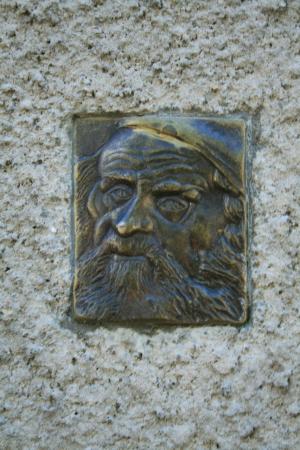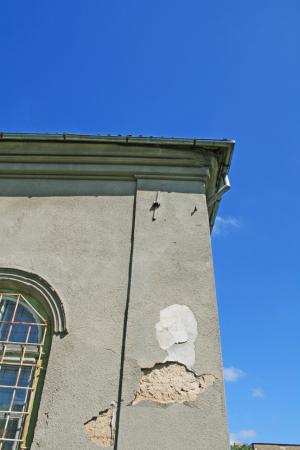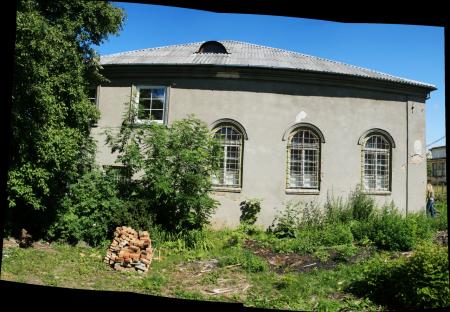Obj. ID: 9268
Jewish Architecture Soldiers’ Beit Midrash in Telšiai, Lithuania

The beit midrash – on the plot belonging to Moshe Levin near Plungė (today Respublikos) Street – was designed in 1866 . The design shows a Neo-Classicist building with a broad eastern prayer hall. The two-storey western façade had a central entrance doorway flanked by two narrow windows. However, the actual building differed from the design: the prayer hall became larger, its eastern wall was pierced by six (rather than four as originally planned) windows. It is hard to establish whether the gable pierced by a central oculus was ever built, or the beit midrash was covered with a hipped roof, like the one it has today.
The name Soldiers’ Beit Midrash derives from the fact that the Jewish conscripts to the Russian army used to take their oaths there. The Soldiers’ Beit Midrash was used by the local Zionists for organizing public lectures on Jewish history in 1906–7. It suffered heavily during the 1908 fire. A photograph by Chaim Kaplanski shows that only bare walls remained. The beit midrash was apparently rebuilt after the fire, and served the community until 1941.
The square-plan building, with a prayer hall, two-storey part and a cellar, is built of brick on a somewhat wider socle; it is plastered, and covered with a hipped roof of asbestos sheets over a former tin covering. The corners of the façades are accentuated by lesenes, and the walls are crowned with a molded cornice. The windows of the two-storey part are rectangular, framed with molded surrounds on the first floor. Nine of twelve former windows of the prayer hall have survived, three on the southern and six on the eastern façade. They are tall and round-headed, decorated with molded archivolts. The main western façade is two-storey; its tiers are separated by a wide plain stringcourse. The central part of the façade contains a wide doorway and narrow windows of the porch on the sides. A narrower new door set up on the left side disrupts the original symmetry of the façade. Most of the windows are wide and rectangular; the windows of the first floor (except the middle one) are framed with molded surrounds; the middle window is surrounded by a wide frame. The southern and northern façades clearly show the prayer hall and two-storey part. The part of the northern façade is concealed by a later-built low annex of silicate bricks covered with a gable roof. The eastern façade is symmetrical, with six high round-headed windows. The windows are arranged in groups of three, with a wider middle pier indicating the interior location of the Torah ark. The prayer hall was situated on the eastern side of the building; it was accessed via the vestibule. Small rooms were located on the south and north of the vestibule; the southern one housed the staircase. Entrances connecting the prayer hall with the rooms on either side of the vestibule were marked on the inventory plan of the former beit midrash from 1951. The broad prayer hall had twelve windows; two stoves were placed at its western wall on both sides of the entrance. In the upper part of this wall, there were seven arched openings, which connected the first-floor women’s section with the prayer hall; in 2007 they were blocked, and three square windows are placed instead. In 2007 the women’s section, which formerly occupied the entire first floor, is partitioned into a corridor on the east, and a row of rooms on the west. Wide arched openings, once connecting the women’s section with the prayer hall, have survived in the corridor. The floor is accessible through a new wooden staircase.
In the Soviet period the former beit midrash accommodated a children’s sports school, and the prayer hall was converted into a gym. Today the building houses a furniture store. In 2002 the building of the former Soldiers’ Beit Midrash was listed as a cultural monument.
sub-set tree:
Cohen-Mushlin, Aliza, Sergey Kravtsov, Vladimir Levin, Giedrė Mickūnaitė, Jurgita Šiaučiūnaitė-Verbickienė (eds.), Synagogues in Lithuania. A Catalogue, 2 vols. (Vilnius: VIlnius Academy of Art Press, 2010-12)

























